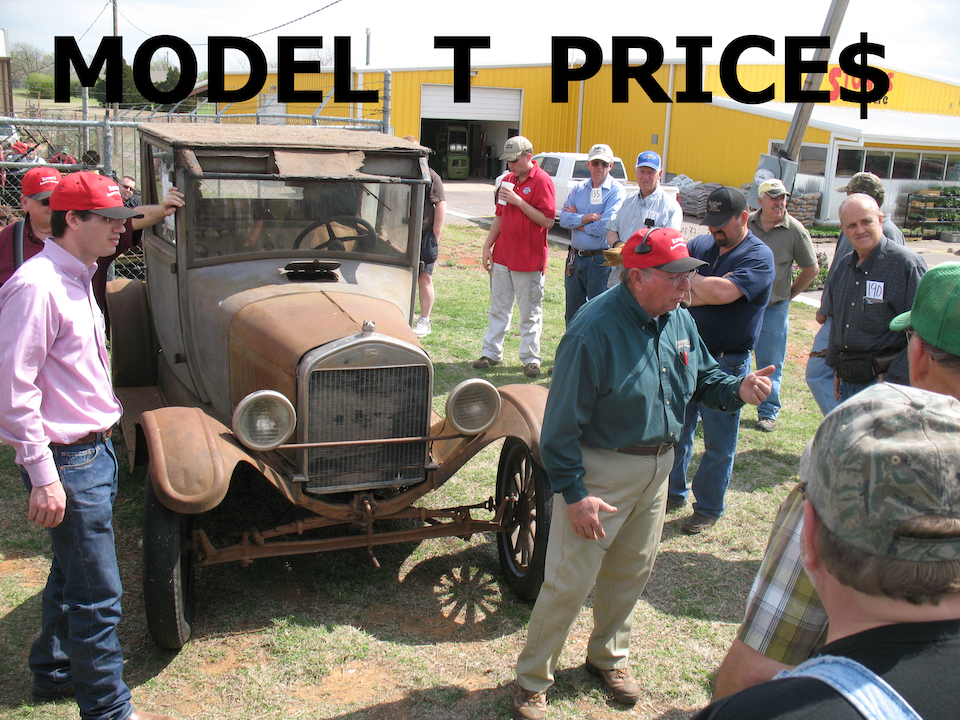HOME
VEHICLE INDEX
This general guide posted by David Grant Stewart on the Model T
Ford Club of America forum in 2003 is still pretty accurate.
Selling prices have not changed much since then, despite the high
asking prices often advertised.
Ignoring the impossibility of such a request, I [David] submit my observations in the hope
that they may provide some orientation to some uninitiated
soul who would like some guidance without having to become an
expert. Model T Values - Thumbnail sketch, in United States 48
contiguous states as of Monday 10 March 2003:
Cars and
original depot hacks and pie wagons 1917-27:
Parts car
only, not restorable: <$1000
Not
complete, restorable with a lot of work, engine may or may not
run: $1,000
Mostly
complete, correct, disassembled, restorable: $2,000.
Mostly
complete, correct, recently assembled, restorable: $2,500.
Complete,
correct, never disassembled, restorable: $3,500.
Runs,
drives, correct, needs total restoration $4,500
Runs and
drives, mostly correct, looks like a 10 year old used car:
$6,000.
Everything
works, not correct (wrong year engine, etc.), looks decent:
$6,000.
Everything
works, almost all correct, looks decent: $7,500.
Show room
condition, correct, needs nothing functionally or
cosmetically: $10,000.
Completely
"restored" but with incorrect "upgrades" such as pre-1919
starter, incorrect accessories, etc.: $10,000 but buyers will
be a different group than previous item.
Rip van
Wrinkle: Car stored inside since new, less than 1000 miles:
$20,000.
Complete
factory type restoration, every nut and bolt reconditioned,
completely correct: Ought to be worth $20,000, but the market
will not pay much more than $12,000.
Trucks
other than original pie wagons: Deduct 50%
Depot
hacks, reproduction bodies: Deduct 50%
Speedsters,
reproduction bodies: Deduct 50%
Town cars
with original bodies: Add 100%
Pre-1917:
Add $1000 for each year down to 1909.
Body only:
60% of the value of the car. Chassis only: 40% of the value of
the car.
Generally, cars needing
total restoration are overpriced because they are a liability,
not an asset, and the cost of restoring them far exceeds their
finished value. This is unfair, but true. Generally, cars
restored with thousands of hours of expert work are
under-priced, but no one will pay their true value. Again,
itís unfair, but true. If you want to make money restoring cars, the best
way to do it is to buy a car that is complete, original, and
basically sound, but does not run. Spend 50 hours and $500 on
it fixing only what is broken and give it a nice paint job so
that when you're done it runs, everything works, and it looks
decent, and advertise it for twice what you paid for it. If
you want to do it right (partial translation: take everything
completely apart), forget about making money. Subsidize it
with your regular job. Buy a good working car to enjoy until
you get this one done. It will take longer than you thought.
It will cost more than you thought. It is impossible to
restore any part without complete dismantling. You never know
what you have until you take it apart. Caution: For any car
that has been "restored" request a photographic record of each
stage, and information on the experience, background, and
motivation of the restorer. The word means ten different
things to ten different people.
HOME
VEHICLE INDEX

